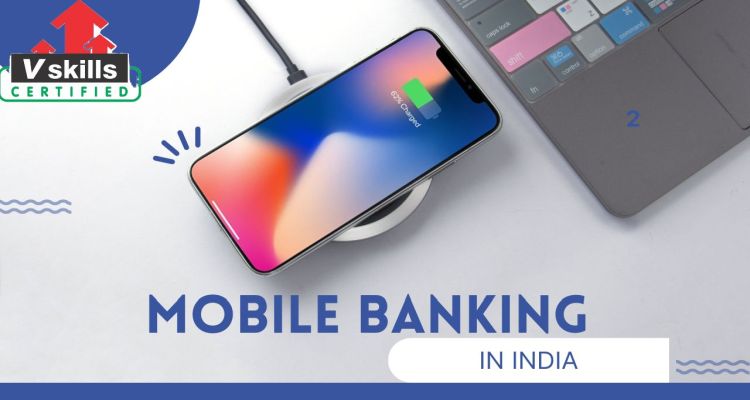Mobile banking has emerged as a transformative force in the Indian financial landscape, reshaping the way individuals manage their finances and interact with banks. With the widespread adoption of smartphones and the increasing availability of mobile internet, mobile banking has become a crucial tool for financial inclusion and convenience.
In this blog, our focus will be on discussing the role of mobile banking in the Indian financial landscape. So, let’s begin this blog with a brief introduction to mobile banking in India.
Introduction of Mobile Banking in India
In India, mobile banking refers to the use of smartphones or feature phones to access various banking services and perform transactions through mobile applications or SMS-based services provided by banks. This technology-driven approach has greatly expanded the reach of traditional banking services beyond urban centers, making financial services accessible to a larger segment of the population.
One of the key drivers of mobile banking’s growth in India has been the government’s push for financial inclusion through initiatives like the Pradhan Mantri Jan Dhan Yojana (PMJDY) and the Aadhaar identification system. These efforts have enabled millions of previously unbanked individuals to open bank accounts and link them to their mobile numbers, allowing them to access basic financial services through mobile banking apps.
Mobile banking offers a wide range of services, including account balance inquiries, fund transfers, bill payments, and mobile recharges. These services are often available 24/7, providing customers with the flexibility to manage their finances at their convenience. Moreover, the use of biometric authentication and multi-factor security measures has helped in building trust and ensure the security of transactions.
Mobile banking has also revolutionized the way payments are made in India. The introduction of the Unified Payments Interface (UPI) has allowed users to seamlessly transfer funds between bank accounts using their mobile phones. This has led to a surge in peer-to-peer (P2P) transactions and the growth of digital payment platforms. Businesses, from small street vendors to large e-commerce platforms, have embraced mobile banking to accept payments, contributing to the country’s transition toward a more cashless economy.
In addition to convenience, mobile banking has played a pivotal role in promoting financial literacy. Users can access information about various financial products, learn about saving and investing, and even participate in digital banking workshops through mobile applications. This has empowered users to make informed financial decisions and take control of their economic well-being.
However, the rapid adoption of mobile banking has also brought challenges. Ensuring cybersecurity and safeguarding user data are paramount concerns. As more sensitive financial information is stored and transmitted through mobile devices, the risk of data breaches and cyberattacks increases. Banks and financial institutions must continue to invest in robust security measures and educate users about safe mobile banking practices.
Thus, mobile banking has significantly transformed the Indian financial landscape by bridging the gap between traditional banking services and the digital age. Its accessibility, convenience, and potential for financial inclusion have made it a cornerstone of the country’s banking sector. As technology continues to evolve and more individuals gain access to smartphones, the role of mobile banking is likely to become even more pivotal in shaping the future of finance in India.
Mobile banking has significantly transformed the Indian financial landscape. It has made banking services more accessible, allowing users to check balances, transfer funds, pay bills, and even apply for loans using their smartphones. This has especially benefited people in remote areas with limited access to traditional banking. Mobile banking has also played a crucial role in advancing financial inclusion by bringing more people into the formal banking system. The growth of mobile banking has prompted banks to invest in digital infrastructure, enhancing efficiency and reducing operational costs. However, challenges related to security, digital literacy, and connectivity remain important considerations for its continued growth.
Mobile banking has emerged as a transformative force within the Indian financial landscape, reshaping the way individuals, businesses, and the banking sector as a whole interact. With the proliferation of smartphones and the expansion of internet connectivity, mobile banking has bridged gaps, catalyzing financial inclusion, enhancing efficiency, and empowering millions.
Role of Mobile Banking in India
1. Financial Inclusion:
One of the most significant impacts of mobile banking in India has been its contribution to financial inclusion. Traditional banking services often remain out of reach for remote and underserved populations due to the lack of physical infrastructure. Mobile banking has brought banking services to the fingertips of these individuals, allowing them to access basic financial services without the need for a physical branch. This has played a pivotal role in reducing the gap between urban and rural areas in terms of banking access.
2. Accessibility and Convenience:
Mobile banking has provided unprecedented convenience to users by enabling them to carry out banking transactions anytime and anywhere. Whether it is checking account balances, transferring funds, paying bills, or even applying for loans, these tasks can now be accomplished with a few taps on a smartphone. This accessibility has not only saved customer’s time but has also reduced the need to visit physical bank branches, contributing to operational efficiency for banks.
3. Cost Efficiency:
For both banks and customers, mobile banking has proven to be a cost-effective alternative. Banks have been able to reduce overhead costs associated with maintaining physical branches, while customers save on travel expenses and time. This has allowed banks to extend their services to more areas and offer better pricing on products due to reduced operational expenses.
4. Digital Transformation of Banking:
The growth of mobile banking has prompted traditional banks to invest heavily in digital infrastructure. Banks are required to innovate and develop user-friendly mobile apps and online platforms to stay competitive. This digital transformation has led to increased efficiency in banking operations, streamlined processes, and the development of new products and services that cater to changing customer preferences.
5. Payment Revolution:
Mobile banking has played a pivotal role in the transition to a cashless economy in India. Mobile wallets and Unified Payments Interface (UPI) platforms have gained immense popularity, allowing users to make quick and secure payments using their mobile devices. UPI, in particular, has revolutionized peer-to-peer payments and merchant transactions, fostering financial integration and reducing dependency on cash.
6. Enhanced Security Measures:
While concerns about security remain, mobile banking has also led to the development of advanced security measures. Biometric authentication, two-factor authentication, and encryption protocols have been implemented to protect user’s financial information. However, ongoing efforts are required to educate users about safety practices to minimize risks related to cybersecurity.
7. Digital Literacy and Education:
The rise of mobile banking has underscored the importance of digital literacy. Many users, especially in rural areas, may not be familiar with using smartphones and digital interfaces for financial transactions. As a result, initiatives aimed at enhancing digital literacy have become essential to ensure that all segments of the population can benefit from mobile banking without encountering barriers.
8. Role in Government Initiatives:
Mobile banking has played a pivotal role in various government initiatives, including the Pradhan Mantri Jan Dhan Yojana (PMJDY) and Direct Benefit Transfer (DBT) programs. These initiatives aim to provide financial services and subsidies directly to beneficiaries’ bank accounts, reducing leakages and ensuring targeted delivery of welfare benefits.
9. Future Prospects:
The future of mobile banking in India remains promising. As technology continues to evolve, mobile banking is likely to become even more sophisticated. Artificial intelligence, machine learning, and big data analytics could be leveraged to provide personalized financial advice, risk assessment, and customized products. However, expanding mobile banking’s reach will also necessitate continued investment in network infrastructure to ensure reliable connectivity in remote areas.
The role of mobile banking in India is not limited to individual consumers. Small and medium-sized enterprises (SMEs) have also benefited greatly from this technology. Mobile banking platforms offer business owners the ability to manage their finances, receive payments, and make transactions without the need for extensive paperwork or physical visits to banks. This has streamlined operations and boosted the efficiency of SMEs, contributing to economic growth.
However, the widespread adoption of mobile banking has also brought about certain challenges. Digital illiteracy, particularly among the elderly and marginalized populations, remains a hurdle. Security concerns related to cyber threats and fraudulent activities have also emerged. Ensuring robust cybersecurity measures and promoting digital literacy are crucial to address these challenges and maintain trust in mobile banking systems.
In conclusion, mobile banking has undeniably reshaped the Indian financial landscape. Its impact spans from enabling financial inclusion and accessibility to driving the digital transformation and reducing costs for both customers and banks. The ongoing challenge lies in ensuring that the benefits of mobile banking are accessible to all segments of the population, regardless of their location or level of digital literacy. With the right strategies and investments, mobile banking can continue to be a driving force in India’s journey towards a more inclusive and technologically advanced financial ecosystem.
Future of Mobile Banking in India
The future of mobile banking in India appears promising, driven by a confluence of technological advancements, increasing smartphone penetration, and evolving consumer preferences. As one of the fastest-growing economies with a vast unbanked population, India’s mobile banking landscape is set to undergo significant transformations in the coming years.
- Firstly, the proliferation of smartphones and affordable data plans has democratized access to digital services, including mobile banking. This trend is expected to continue, enabling even rural and remote populations to engage with financial services through their mobile devices. As smartphones become more accessible, user-friendly interfaces and innovative apps will enhance the mobile banking experience, catering to users from various demographics.
- Secondly, the push towards a digital economy by the Indian government, evidenced by initiatives like “Digital India” and “Unified Payments Interface” (UPI), lays a strong foundation for mobile banking growth. These measures facilitate seamless digital transactions, boosting the adoption of mobile banking platforms. With UPI enabling instant and secure fund transfers, mobile banking will likely become an integral part of daily financial transactions for Indians.
- Furthermore, advancements in biometric authentication and security measures will address concerns regarding the safety of mobile banking. Biometric methods such as fingerprint and facial recognition are becoming more reliable, providing convenient yet secure access to accounts and transactions. This will foster trust among users who were initially wary of digital financial services.
Personalization is another key aspect of the future of mobile banking in India. With the accumulation of user data and the growth of AI-driven technologies, banks can offer tailored financial solutions and recommendations. This could include personalized savings goals, investment options, and budgeting insights, enhancing the value proposition of mobile banking beyond basic transactions.
The integration of mobile banking with other services is also on the horizon. Banking platforms could evolve into comprehensive financial hubs, offering insurance, wealth management and even educational resources. This holistic approach would position mobile banking as an essential tool for managing various aspects of an individual’s financial life.
Collaborations between traditional banks and fintech startups will likely play a crucial role in shaping the future of mobile banking in India. Fintech companies bring agility and innovation, while established banks contribute their expertise and regulatory compliance. Such partnerships can lead to the development of cutting-edge features and services that cater to a diverse range of customer needs.
Conclusion
In conclusion, the future of mobile banking in India is poised for remarkable growth. Technological advancements, government initiatives, increasing smartphone usage, and innovative collaborations are all contributing factors. The evolution of mobile banking will be characterized by enhanced accessibility, security, personalization and integration with other financial services, making it an indispensable tool for financial management and transactions for millions of Indians across the country. The role of mobile banking in India has been transformative and multi-faceted. It has democratized access to financial services, promoting financial inclusion, reducing the reliance on cash, and spurring economic growth. While challenges exist, the potential benefits of mobile banking in the Indian financial landscape far outweigh the drawbacks. As technology continues to evolve, mobile banking is likely to play an even greater role in shaping the future of India’s financial landscape, driving innovation, and creating opportunities for millions.




